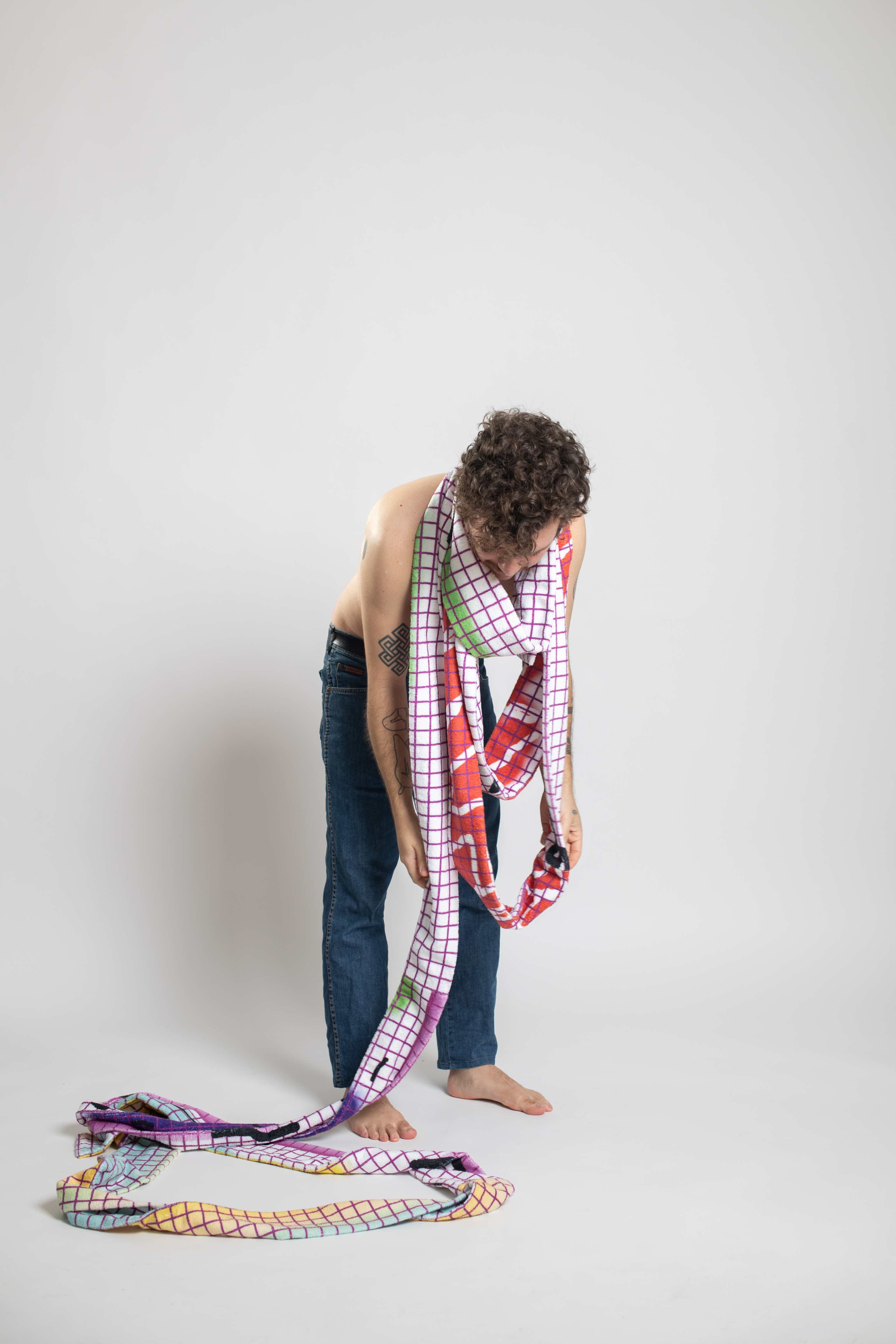
Ungetrübtes Glück, 2022, wax, latex. Photo by Ana Rodriguez
Francisco Valenca Vaz. Apples of gold in a setting of silver
Cotton does not deceive, polyester does. With the proliferation of social media, it seems as if the artist will be transformed into a product along with their work. Processing this, the installation Apples of gold in a setting of silver uses elements of stage design and different material references to stage icons of ourselves.
In a photograph the artist sketches himself by imitating the positioning of the object being held up by his body. As part of the installation, this photograph evoking a snake contributes to the dematerialization of known everyday surroundings and symbols in order to decode them; are the plastic and microfiber objects the new baroque symbols reminding us that everything will pass?

Trost der Dinge, 2022, Photo by Fernanda Nigro
This scarf-like item makes reference to the act of painting on a surface, whereby action remains visible through its materiality. In the installed photograph this reminiscence on painting within the object functions as a performative act to emphasize meanings, such as the artist's problematic need to produce.
Printed towels can also be seen folded or hung in the installation. The towel is itself an object that suggests interpretations in relation to the viewer's body, functioning on the principle that we can remember moments when we used a towel. Every time we dry ourselves, we expand our understanding of our material body unconsciously and daily; a self-sculptural experience. In contrast to this level of physicality, these printed images are produced on the computer, where the painterly craftsmanship disappears and the artist is no longer present on this level, but with a laptop as a machine between the real and virtual "world" (absent-mindedness). A sacred virtuality related to the cloud of the Internet, in the sky, with a promised unreachable reality. Possibly a portal.

In a similar way, the images printed on the shower curtains suggest that something external is hiding behind these curtains, or on the contrary, that the sheer superficiality of these objects has nothing special to say. They are both objects made of weak materials that are stuck in a time of durability without a future, as well as prophecies that promise processes of industrialization. On a Plexiglas shelf, six transparent screws called "grey theory". Finally, a slowly melted wax LED lamp on the floor, accompanied by the dismemberment of the artist's latest ideas.
Those painting references are not about the direct question of what painting could be, but about trying to develop an interdisciplinary form of imagination within the framework of possibilities. A word spoken in its time, like apples of gold in a bowl of silver. (25:11) The little plastic apples on the textiles are eternal fruit that endures the passage of time. Here a scene is proposed for the viewer, in which the fruit becomes the mimetic protagonist and the installation mutates into a staged space.
RADEK KROLCZYK. THIS IS HOW THE GLORY OF THE WORLD PASSES
The fame of the world (Der Ruhm der Welt) perishes on the body of the glorious artist. He seeks the consolation that the capitalistically reified and now also warring world denies him in the things of art. It is said of things of art that they are at odds with the world, that they are resistant. A colored scarf is now wrapped around the artist's tired body as an art object that promises consolation, but this promise disappoints: it just hangs heavily on the tired body, tiring him out instead of giving him strength and comfort. Its synthetic material and its synthetic pattern assert dynamism and intensify the cold. Alienating paid labor exhausts the body; the artistic work originates with a promise, then becomes similar to paid labor and only exhausts the body more. The thing that promises consolation finally appears on the wall as a drawing or artistic signature, as a merely aesthetic residue, freed of body, work and exhaustion. The flickering lines that now surround it make the thing of dead work appear alive. As a play of light they finally ennoble the thing of dead work as a sanctuary, as an autonomous work of art.